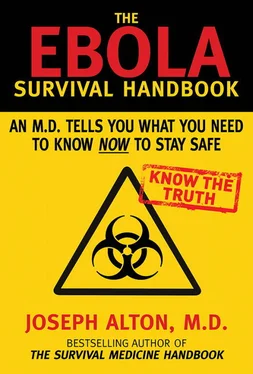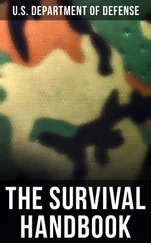Compare the above to official CDC recommendations for health-care professionals and you’ll see that you can follow most of the guidelines in your own home rather effectively.
HEALTH-CARE PROFESSIONAL PRECAUTIONS
• Treat each person in their own area, with their own bathroom, if possible, or at least provide a barrier between patients.
• Take a careful log of medical professionals entering and exiting the room.
• Absolutely no visitors—only health-care providers permitted, and only those specially assigned to the case.
• Protective gear should be worn by all medical professionals entering the room—gloves, gowns (fluid resistant or impermeable), eye protection (goggles or face shields), facemasks, as well as double gloving, leg coverings, and disposable shoe coverings to protect from copious amounts of blood, other bodily fluids, vomit, or feces present in the environment.
• Only dedicated, preferably disposable medical equipment is to be used. That which is not disposable needs to be cleaned and disinfected regularly.
• Limit use of needles, and take extreme care when used; dispose in puncture-proof, sealed containers.
• All aerosol-generating procedures should be avoided if possible; if not, a combination of measures to reduce exposures from aerosol-generating procedures should be employed, ideally in an Airborne Infection Isolation Room (AIIR) with closed door and limited exit and entry.
• Health-care providers should wear gloves, gowns, disposable shoe covers, and either a face shield that fully covers the front and sides of the face or goggles, and respiratory protection that is at least as protective as a NIOSH certified fit-tested N95 filtering face piece respirator or higher (e.g., powered air purifying respirator) during aerosol-generating procedures.
• The surfaces in the room should be cleaned regularly.
• Collection and handling of soiled reusable respirators must be done by trained individuals.
• Hands should be washed before and after all patient contact, and before putting on and upon removal of PPE, including gloves.
• If contact is made with fluids, health-care provider should stop working and immediately wash the affected skin surfaces with soap and water. Mucous membranes (e.g., conjunctiva) should be irrigated with copious amounts of water or eyewash solution, and an occupational health/supervisor should be contacted for assessment.
TIP
Health-care providers should wear gloves, gowns, disposable shoe covers, and either a face shield that fully covers the front and sides of the face or goggles, and respiratory protection that is at least as protective as a NIOSH certified fit-tested N95 filtering face piece respirator or higher (e.g., powered air purifying respirator) during aerosol-generating procedures.
• Health-care providers who develop sudden onset of fever, intense weakness or muscle pains, vomiting, diarrhea, or any signs of hemorrhage after an unprotected exposure (i.e., not wearing recommended PPE at the time of patient contact or through direct contact to blood or bodily fluids) to a patient with Ebola should immediately stop working, notify their supervisor, seek prompt medical evaluation and testing, notify local and state health departments, and comply with work exclusion until they are deemed no longer infectious to others.
• An asymptomatic health-care provider who had an unprotected exposure should receive medical evaluation and follow-up care including fever monitoring twice daily for twenty-one days after the last known exposure. (Source: CDC.gov)
DISINFECTANT SUPPLIES
Some supplies are disposable, but some aren’t and can be reused. In good times, when items like coveralls are plentiful, these should be considered disposable. In a true pandemic setting, these supplies may be unavailable for the foreseeable future. In this case, you may have to make a decision to reuse supplies you should throw away. This is not something I think is wise, but your circumstances will dictate your actions. Understand that your level of protection will likely decrease significantly.
Disinfection, if done properly, will kill the Ebola virus. The virus is not particularly hardy, and simple materials like soap, alcohol, and bleach will help eliminate it from surfaces. Things that must be disinfected include:
• Hands and skin, whenever exposed
• Gloves
• Thermometers, stethoscopes, and other instruments
• Spills on walls, floors, or work surfaces
• Patient waste
• Patient bedding
• Needles and syringes
When disinfecting, use the same personal protection gear that you would when treating the patient.
BLEACH SOLUTION
A simple and inexpensive way to keep your sick room clean is with a solution of bleach. Ordinary household bleach can be prepared in a strong (1:10) solution and a weaker (1:100) solution. The strong version is for disinfecting patient waste and for disinfecting spills of blood, mucus, or other bodily fluids. The weaker version is useful for disinfecting surfaces, bedding, medical equipment, and reusable protective clothing (which shall then be washed). It can also disinfect aprons, boots, and items to be thrown away. Yes, items you discard must be disinfected.
To prepare a bleach solution, you’ll need:
• A mixing container that can hold ten “measures.” For example, a ten-cup container.
• Containers to hold the solutions (consider labels or separate colors for the 1:10 and 1:100 solutions).
• Chlorine bleach
• Clean water
• A measuring cup or similar item
Now, mark the mixing container at the 90 percent level. This will tell you the proper proportions for your mix. Then, pour water to the 90 percent level and add the rest with your bleach. You have just made your 1:10 solution.
To make your 1:100 bleach solution, pour water to the 90 percent level in a new container and use your 1:10 bleach solution to fill the rest of the way.
Prepare these solutions daily, as bleach loses its strength quickly. Smell the solutions; they should have a “bleach-y” odor. If they don’t, the bleach has degraded and should not be used. For organization purposes, prepare your solutions at the same time every day.
CLEAN SURFACES
As surfaces such as tabletops, sinks, walls, and floors are not generally involved in the transmission of Ebola virus, they may not need intensive cleaning. However, daily maintenance is a good strategy.
WALLS, FLOORS, AND WORK SURFACES
For “clean” walls and floors, mop or otherwise clean with 1:100 bleach solution.
For spills or splatter on walls and floors, pour 1:10 bleach solution and let soak for 15 minutes before removing with a towel. Discard the towel.
BEDDING
For plastic sheeting:Remove liquid or solid waste with absorbent towels, then discard. Wash with 1:100 bleach solution daily.
For cloth sheeting:Remove sheets from the bed and place in a bucket or plastic bag. Soak in bleach solution for 30 minutes. Remove and place in soapy water overnight. Rinse and line-dry.
Mattresses:If heavily soiled, remove and burn (this is why plastic sheeting is so important). If the mattress must be reused, soak in 1:10 bleach until soaked on both sides. Dry in the sun (on both sides) for several days.
PATIENT UTENSILS
Eating utensils are medical supplies, too. Wash and rinse in 1:100 bleach solution and then air-dry.
PATIENT WASTE
Cover the contents of a bedpan or waste bucket with 1:10 bleach solution then empty the contents into a dedicated patient toilet or latrine. Rinse in 1:100 bleach solution before returning it to the sick room. For toilets, beware of splatter.
Читать дальше



![John Stieber - Against the Odds - Survival on the Russian Front 1944-1945 [2nd Edition]](/books/405234/john-stieber-against-the-odds-survival-on-the-russian-front-1944-1945-2nd-edition-thumb.webp)








